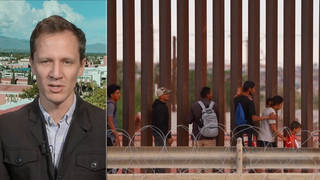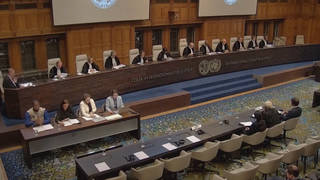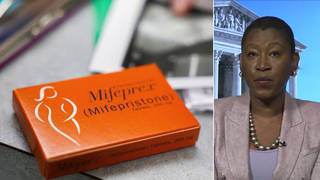
Related
Guests
- Silky Shahexecutive director of Detention Watch Network.
There has been “no moral leadership from the Biden administration and the Democrats” on immigration policy, argues Detention Watch Network’s Silky Shah in Part 2 of our interview about her new book, Unbuild Walls: Why Immigrant Justice Needs Abolition. She recalls Biden’s early vow to reduce immigration detention, cut contracts and check enforcement, but backslide when “Republicans quickly took back the narrative.” She discusses how immigrant justice movement organizers are now working toward a vision of abolition, beyond the criminal system and comprehensive immigration reform.
Transcript
AMY GOODMAN: This is Democracy Now!, democracynow.org, The War and Peace Report. I’m Amy Goodman in New York. Juan González is in Chicago.
We continue now with Part 2 of our interview with Silky Shah. She’s the executive director of Detention Watch Network and just authored the new book, Unbuild Walls: Why Immigrant Justice Needs Abolition.
As we’ve reported, the Biden administration is preparing new measures that could expedite the deportation of some asylum seekers deemed unlikely to qualify for protection in the early stages of the process. Immigrant rights organizations warn the new rules will further erode due process rights for migrants. President Biden has also faced mounting criticism for supporting similar anti-immigrant policies as President Trump before him, leading to mass deportations and the separation of families.
Meanwhile, despite reports of physical and psychological violence in ICE jails and demands to shut them down, President Biden in March signed a federal spending bill that dramatically increased funding for ICE and Customs and Border Protection. This comes as many polls put immigration as the number one or number two issue in the likely — in the rematch between President Biden and Donald Trump in November. I mean, this hasn’t happened in decades that immigration is number one or number two, sometimes ahead of the economy.
Silky, let’s start there, in talking about how this issue rose so high. I was just talking to a person I had just met from Uzbekistan, who is so thrilled to be able to come here as an immigrant. And I said to him, you know, talking about the election, “What do you see as the most important issue?” He said, “Immigrants, millions of illegal immigrants.” I said, “You came from Uzbekistan. And you’re concerned about people coming into this country?” Can you explain what’s happened?
SILKY SHAH: Yeah, absolutely. I mean, I think part of what’s happened is that we’ve seen absolutely no moral leadership from the Biden administration and from the Democrats at all. And, unfortunately, I mean — and we can just remember a few years ago, in 2018, when family separations were happening, 2017, with the Muslim ban, during the Trump era, there was actually a lot of people really understanding the harms of our immigration system. They were being exposed in a new way. And really, you know, that early moment in Biden, I have to say, is one of the more hopeful moments I had. We saw Biden implement a moratorium on deportations, really have a check on ICE agents, really start to look at reducing the detention system, and ended some contracts to immigration detention, and it was really exciting. But quickly, the Republicans took back the narrative and sort of really elevated a sort of border panic. And the Democrats have had zero vision and have sort of had just the sort of craven policy of, “Well, we want to keep immigration out of the news, so we’re actually just going to go to the right on this and hope that we do something to show that we’re doing something, without actually sort of addressing the question.”
And the other thing I would say that’s happened is that at this point Governor Greg Abbott of my home state of Texas is pretty much dictating immigration policy, because the Biden administration hasn’t shown any leadership on this issue at all. And so, through the busing of migrants to places like New York City and Denver and Chicago, actually, it’s created all these sort of, you know, difficult situations with the social safety nets in those cities, where, you know, just 10 years ago, it actually wasn’t that hard for New York to accept migrants, but there was more infrastructure. And since the pandemic, I think a lot of social safety nets have been frayed to some degree. And so that’s part of the problem. Of course, there is a housing crisis. There’s mass social inequality. People are really struggling. And so, immigrants become an easy scapegoat. And, you know, the Republicans have really pushed that. And because the Democrats have ceded so much ground to the Republicans and accepted this, now immigration is, you know, this major issue in the conversation.
JUAN GONZÁLEZ: But there is a reality that the number of people crossing into the U.S. is at virtually record levels. And do you think that, to some degree, that the failure is not so much of the narrative, but clearly explaining that there’s a crisis occurring in many of the countries, especially in Latin America, that the U.S. has repeatedly failed to address as it’s been so involved in Ukraine and in the Middle East and other parts of the world, that the growing disparities are — at the same time that there are many jobs — there are 10 million unfilled jobs in the United States, and the migrants who are coming know that.
SILKY SHAH: Yeah, absolutely. I mean, I think it’s so important for us to understand the root causes of migration. For many years, so much of the conversation in the immigrant rights movement was, “Well, immigrants are patriotic. They’re American.” And, actually, the trade-offs on border militarization were a way to get legalization. And actually, the movement hasn’t embraced a sort of more anti-imperialist sort of framework. And years ago, in the 1980s, during the sanctuary movement, there was a much more internationalist sort of understanding of what was happening in Central America and the reasons why people were migrating, and ability to sort of have that conversation. So, I think that’s really an important piece of the work that we need to do.
But I also think these more and more restrictionist policies of the border are the thing that have created this manufactured crisis there. The reality is, having these restrictionist policies, people are going to come regardless. Migration is a reality. And the sort of response has been either criminalization or deterrence or militarization. And what that means is, actually, that gives sort of power to people to exploit migrants, and so, you know, questions of smuggling or human trafficking. Migrants want to come regardless, but those are the avenues they take because there aren’t legal pathways and opportunities for people to come on their own. And also, there’s no freedom of movement. I mean, you know, there’s so much we can say about what happened in the 1990s around these policies, but in '96, there was a policy that passed that said, you know, people are basically barred from reentering the country if they came without documentation. And, you know, that meant a lot of people were trapped. And so, because there's no freedom of movement and ability for people to go back and forth or sort of figure out, you know, maybe come for a few years or go back or have more legal pathways, that’s why we have this sort of manufactured crisis at the border.
JUAN GONZÁLEZ: And your sense of a potential return of Donald Trump to the presidency in terms of his promises of mass deportation like never before in American history? And, of course, we’ve had the deportation dragnets of the Hoover era and then Operation Wetback of the Eisenhower era.
SILKY SHAH: Yeah. I mean, I think Trump becoming president again is absolutely a terrifying prospect. And I think one of the things that we can anticipate is going back to those mass raids. I mean, one of the big wins of the sort of Obama era and Biden era, there aren’t the sort of scale of workplace raids and home raids and other things that are happening that are targeting community members. And so, I think we can anticipate that. During the Trump era, there was proposals to have, you know, 15,000 more detention beds and big detention camps at military bases. And so, that’s another possibility, bringing the National Guard in. I mean, a lot of actually what’s happening in Texas through Governor Abbott’s Operation Lone Star program, I can imagine a lot of that, these mass prosecutions, happening actually across the country, and that’s really concerning.
AMY GOODMAN: I want to go back to April 2021, when President Biden spoke in Duluth, Georgia, to mark 100 days of his presidency, his speech interrupted by protesters calling for an end to detention centers.
PROTESTERS: End detention now! End detention now! End detention now! End detention now! End detention now! End detention now!
PRESIDENT JOE BIDEN: We’ll give you a microphone.
PROTESTERS: End detention now! End detention now! Abolish ICE! Close private detention centers now, please! Abolish ICE!
PRESIDENT JOE BIDEN: I agree with you. I’m working on it, man. Give me another five days.
AMY GOODMAN: There’s President Biden saying, “Give them a microphone,” as they chanted “End detentions now.” And he said, “Give me, what, five days.” So, if you can talk about the organizing? Because that’s really at the heart of your book, Unbuild Walls. And tonight at People’s Forum, you’re going to be sharing stories of successful fights, how people are organizing. Tell us some of those stories, Silky.
SILKY SHAH: Yeah, absolutely. I mean, I think one thing that was really exciting about — and part of the reason why I’m still so committed to this idea of abolition — is that, actually, our ability to make the case opened up so much more in 2020 during the Black Lives Matter uprisings, the George Floyd uprisings across the country, millions and millions of people coming out and really questioning these systems. And actually, that’s when the immigrant rights movement, the immigrant justice movement became a lot more open to the idea of detention abolition. Before that, it was so — it was sort of just expected, and the conventional wisdom was there. It was like, “Sure, some people need to be detained.” But then, at that point, it was like, “Well, why do people need to be detained?” In fact, you know, people are in immigration detention awaiting a hearing or awaiting deportation. They can be at home with their families while they go through those proceedings. And so, it really opened up space for us.
And what was so exciting is that, you know, we had started — we have this sort of national umbrella campaign called Communities Not Cages, where we work with groups across the country to either shut down detention centers or prevent the expansion of new ones. And we’ve seen in places like Illinois, which no longer has any immigrant detention, ICE tried to build a new, like, big facility in the region for years and years. And over eight or nine cases — and I write about this in the book — there was like the most incredible game of whack-a-mole, where they stopped in every single location, working with local leaders who were saying, “No, we don’t want this.” And they actually stopped ICE from getting their mass detention center in the Midwest, which was huge.
AMY GOODMAN: And who was the force behind this? Why did the whole state change?
SILKY SHAH: I mean, it was — what’s so important to understand — and, you know, Detention Watch Network is a coalition — this is about a lot of different groups coming together. It’s faith leaders. It’s community organizers. It’s people who are legal service providers, providing counsel to people. It is, you know, lawyers, advocacy people, elected officials — all sort of understanding. And it opened up space. Of course, people didn’t want to be associated with Trump. But they also were seeing the way, understanding mass incarceration, understanding racist policing better, and that helped them apply those lessons to the immigration system, where a lot of this happened.
And one other campaign I would mention is here in New York and New Jersey. For so many years, immigrants were held in New Jersey detention centers, and there was a lot of effort to shut down facilities and a lot of sort of concern. And I think one thing to understand is, you know — we have a report that shows this — that because of ICE detention capacity — you know, ICE detention exists to facilitate deportation. So, as ICE detention capacity grew, more and more people were being deported, because there was bed space, and there was actually guaranteed minimums, you know, essentially, quotas for this bed space. And then ICE would go and either do home raids or use the local jails to find people to detain, who would then be deported. And so, our argument was actually shutting down detention centers, saying, “No, we don’t want this many people incarcerated, and we don’t want this way to facilitate deportation.” People started to say that in New Jersey, and there was a lot of back-and-forth. And I hope people read that case study in the book, because it’s so, so inspiring to see not just how we changed the elected officials, but also the advocacy community that was really concerned about the detention — you know, this particular detention center closing down, because of access to counsel and other things, but really seeing that actually the closure or the end of the contract was going to help make it so less people were targeted in the region. And now, you know, New Jersey only has one detention center. At some points it had five detention centers. And, you know, they’re trying again to bring in a new one, and there’s going to be a really big fight. And I think it’s been just so amazing. There was, you know, losses in that fight, but people just kept going and going and kind of became this huge nuisance, and the freeholders, the county commissioners, in New Jersey actually finally decided, “We’re going to end this contract, because it just doesn’t make sense anymore.”
JUAN GONZÁLEZ: Well, Silky, you’re talking about some of the successes, but there’s also been challenges, and new challenges, as a result of the current migrant crisis. And, for example, you mentioned Greg Abbott. His busing of migrants and asylum seekers to New York, Chicago, Denver and Philadelphia has now led to striking situations in many communities, where even in the African American and even the historic Latino communities, there’s somewhat of a backlash to local governments dedicating all of these resources to the new migrants while ignoring the people from those original communities.
SILKY SHAH: Yeah. I mean, I think what’s so hard about this, and, you know, I was already talking about, like, so much of it is about, you know, the destruction of the welfare state, the safety nets that existed for so, so many years are not there in the same way. And actually, social inequality has just sort of expanded, expanded, and migrants become the sort of obvious scapegoat. And I think, in so many ways, you know, the “good immigrant/bad immigrant” frame is there, but also you have this sort of — now this sort of, like, “old immigrant versus new immigrant” frame. And I think that’s what’s so hard about, you know, what’s happened with this many, many years of push for comprehensive immigration reform and saying, you know, “We are going to do everything we can to have legalization, but at the expense of people who are wanting to come and for more border militarization and criminalization.”
And that’s what’s so hard, is that, actually, that sort of vision of freedom of movement and what people — what we can do to create legal pathways for people to come, and not create those more restrictionist things that make things worse, not just at the border, but in Mexico and Guatemala and everywhere else. And so, I think that’s a really huge challenge for us. And I think this is going to continue to be a challenge for many years. And obviously, migration continues to be a really big question, not just in the U.S., but across the world. And what we really need to do is sort of start really seeding that sort of vision of what does it mean to have more freedom of movement and less militarized, less criminalized borders.
AMY GOODMAN: Talk about the power of the for-profit prison lobby and how this lobby grew — I mean, companies like GEO — related to immigrant detention.
SILKY SHAH: Yeah, absolutely. I mean, I think it’s really important to understand that the private prison industry is just a sort of gross byproduct of neoliberalism. And, you know, that’s really when, in much of what was happening in the '80s with the sort of growth of this system and this idea of neoliberalism, this idea of small government was there. And so, what happened is, in fact, in Houston, Texas, my hometown, that's where we saw the first private prison ever in the — modern private prison built, and it was an immigrant detention center. And so, from the beginning, there was this, like, very clear relationship between immigration and privatization and the federal government, really seen, as private prisons, as a way to expand, when actually they didn’t want to put more investments in the government.
So, what I think is important to understand is, yes, the private prison lobby has a role, but the reality is, is that so many of these prisons, whether they’re run by private prison companies or counties, you know, so much of it is about a sort of prison economy, a detention economy, where, you know, local jobs are created. Counties are making revenue. There’s this sort of symbiotic relationship between the federal government and these counties. And so, even if it’s a private prison, these counties also get a cut with having the private prison there. And so there’s just all these incentives that are created. And yes, it’s about — and now we have some 80% or more of detention beds are privately operated. But I think what’s — what I sort of argue in the book is, actually, we have to kind of go after the whole system. Yes, private prisons are a problem, but also these county jails are really terrible. And so much of this is about moving away from a detention economy, a carceral economy, where the answer is jobs, like keep a prison open because we have jobs, as opposed to, actually, let’s figure out some other ways to have economies that help people thrive as opposed to incarcerate people.
AMY GOODMAN: And the latest news, the issue of spending on private detention centers, ICE, Immigration and Customs Enforcement, getting $3.4 billion in this fiscal year to expand detention capabilities, maintaining an average daily population of over 41,000 people, Biden signing the federal spending bill dramatically expanding ICE funding, and groups, human rights groups, like Human Rights Watch and Amnesty, saying in an open letter that Biden’s funding was, quote, “an utter betrayal of campaign promises.”
SILKY SHAH: Yeah, absolutely. I mean, it’s — I remain to be hopeful, partly because we saw some shifts. So, what we saw with Biden was actually the ending of contracts at five detention centers that we were really calling for attention to. And also, we saw that, you know, in fiscal year '23, the proposed budget by Biden was actually a 26% cut in detention. But because so much of the backlash and how much the Democrats have really ceded ground here and not remained sort of leaders on this issue, what we've seen is a backsliding.
AMY GOODMAN: Well, you have the Democrats accepting a Republican bill —
SILKY SHAH: Absolutely.
AMY GOODMAN: — that was carved out in Congress. And then, because President Trump wanted to create chaos, even though the Democrats wholly embraced the Republican bill, he then told the Republicans, who had crafted the bill, “No, say 'no' to this. Vote against it.” And they did.
SILKY SHAH: Right, yeah, no. And I think that’s the thing. In the sort of Biden’s mind or the Democrats’ mind is that what we’ve — from there, they’re like, “Look, we’re calling their bluff. We’re showing — we’re exposing them.” But in reality, what they’re saying is, you’re accepting what — essentially, this very sort of right-wing, neofascist, whatever you want to call it, like, policies from the Republicans. And what does that say to the population? Then you’re just — you’re saying, actually, “No, we accept immigration as a problem,” which is a huge, huge concern.
And so, I do — yes, you know, on private prisons, you know, in that clip that you showed, it was, “I’m going to end the private prisons. I’m going to do it now,” and then proceeded to actually, you know, only end it in the Department of Justice, but not end it for DHS, and actually turned some of those facilities at DOJ that the Federal Bureau of Prisons was using into ICE detention centers. So, this constant sort of recycling of beds was happening. And now, yeah, completely backsliding. You know, there was actually this real intention. And I think, unfortunately, because, you know, there is no vision or leadership on this issue, or their vision is essentially like, “Let’s kind of avoid immigration as much as we can,” this is what we have. And we see detention being funded at levels that we’ve never seen before, which is really concerning.
JUAN GONZÁLEZ: Yeah, I wanted to ask you — you mentioned the detention centers, but there’s also the other aspect of this, border security and walls, which is all of the reliance on technology, very similar to what the Israelis have tried to do with the Palestinians in the Middle East with — between cameras, drones, facial recognition software, or the creation — the idea that you can actually wall off the United States with technology from along a 2,000-mile border. I’m wondering your thoughts on the prospects of that and also what it means for us as a society.
SILKY SHAH: I mean, you know, Gaza has been a laboratory for a lot of the systems of control that we’re seeing at the U.S.-Mexico border. And, you know, a lot of what I write about in the book is how much the immigrant justice movement really needs to be a broader sort of racial justice movement and see it as a part of that. But I also think there is that sort of question of sort of anti-imperialism and internationalism and understanding that all these fights are sort of interconnected.
And the reality is, is that, you know, what we saw under the Biden administration, and a lot of this was seeded under Obama for this push for alternatives to detention, which were electronic monitoring, ankle monitors, just a huge, massive expansion of that. So, at some point, under Biden, some 300,000 people were under some form of alternatives to detention, which is essentially an alternative form of detention, either an ankle monitor or a smartphone app. In Denver, they rolled out smartwatches. So, what they’re doing is to have more and more control over more and more people. And, in fact, you know, sort of what we saw was, rather than decarcerate and get people out of detention, these policies just led to more and more people in the sort of wider net under ICE surveillance. And now they’re actually trying to apply that not just to those people who are in the sort of detained docket, but actually any immigrant who has any interaction with USCIS, the immigration service, and also with ICE, being under some form of surveillance. And this is what the private prison industry is actually trying to see as the sort of next terrain of profit.
AMY GOODMAN: Silky, you said something profound a few minutes ago — you’ve said a lot of profound things throughout this interview, but when you said when you see immigration as a problem. So, talk about seeing immigration as an opportunity and as an advantage this country has, and what that world would look like.
SILKY SHAH: Yeah, absolutely. I mean, I think what’s — I think it is so hard sometimes to kind of — you know, immigration is so complicated, and it’s connected to all these issues, and it feels so overwhelming. It’s just very intersectional. But I do think that’s an opportunity to connect it to all these other questions of — whether it’s what’s happening with the criminal legal system, which is really what I’m writing about in the book, but also what’s happening in terms of foreign policy. And sort of, you know, one of the things that’s really amazing is, in this moment, we’ve actually seen shifts from the immigrant justice movement to actually come out in solidarity with Palestinians and show those connections around defunding the military and defunding ICE and CBP.
And I think, with that sort of question of immigration as an opportunity, I mean, obviously, I think, you know, as Juan was talking about before, there is a need for more resources and the ability to have — you know, there’s jobs short — like, people need jobs. People want to come here and support their families. It’s about human connection. It’s about also labor. And so, I think if we were able to kind of shift our thinking away from this idea that immigration is a public safety issue, and say what is it really about and understand it more holistically, it doesn’t just change the conversation in the U.S., but it also changes the conversation abroad. And I think one of the most important things for us to understand is that part of the issue is, in the U.S., there is mass social inequality. And if we can really start to really make things better for people here, it will make things better for immigrants, and it will also help make our case for more immigration or for freedom of movement or people to have the ability to be more fluid. Yeah.
AMY GOODMAN: I want to end where we started, with the title of your book, Unbuild Walls: Why Immigrant Justice Needs Abolition. Within different movements, abolition is just accepted. You don’t have to explain it. But for a broad, global audience, maybe you can talk about the history of the abolition movement — many people just associate it with slavery, not with prisons — and how you took that idea of slavery abolition and apply it today to prisons and detention centers.
SILKY SHAH: Well, a lot of — I mean, so, for me, actually, a lot of this was in the sort of early 2000s and when I was, you know, a young activist and sort of learning about these questions. And what I saw, actually, at the U.S.-Mexico border, being from Texas, was actually that post-9/11, there was essentially another prison boom happening at the border for immigrants. And I became connected to groups like Critical Resistance. And that started in the late '90s by Ruth Wilson Gilmore and Rachel Herzing and a lot of other people who've done this work to sort of apply those lessons, those bigger abolitionist lessons, to what was happening, where we saw more than 2 million people in prison in the U.S. — the U.S. is the world’s leading incarcerator — and really just understanding: How did we get to that?
And so, I think what’s been so helpful about abolition as a framework is that there’s actually just a historical perspective. For me, so much of what we’ve seen in these shifts on immigration, it was actually the Anti-Drug Abuse Act in 1988 that made mandatory detention law. All these policies got worse through tough-on-crime legislation. And we have to understand those interconnections. And so, abolition is both an understanding of that history, but it’s also a lens, and so asking ourselves these questions. And I do this in the book. It is like, “Well, is this system going to — is this, you know, thing that we’re pushing for, whether it’s — is it a reform that legitimizes the system, or is it a reform that’s actually starting to chip away, or is it going to make things worse for other people? And as you look at things like comprehensive immigration reform or the reforms that were proposed under the Obama administration, we saw that, actually, all those things were making things worse. And so, if we have a lens, we’ll have a better understanding of getting us closer to less people being incarcerated.
AMY GOODMAN: And finally, that issue of slavery, for people to understand, it’s the abolition movement. And that’s where you come back to, as well. It’s the movements that make the difference.
SILKY SHAH: Absolutely.
AMY GOODMAN: But how slavery was abolished, and how you see a continuum with the prison abolition movement?
SILKY SHAH: Yeah, absolutely. And I think, you know, I write about this, you know, somebody who’s probably been in here, Ravi Ragbir, a friend of mine, who, you know, was on a electronic monitor. And at some point he was, you know, in the five boroughs of New York but went to the Far Rockaways, and his electronic monitor started talking to him and saying, You are leaving the master zone. You are leaving the master zone.” And it’s such a visceral moment of understanding, actually, how this sort of, you know, deprivation of liberty has just constantly evolves. And that’s sort of the lessons that we have to take from that era of chattel slavery and how things are evolving now.
AMY GOODMAN: Well, Silky Shah, executive director of Detention Watch Network and author of the new book, just out, titled Unbuild Walls: Why Immigrant Justice Needs Abolition. To see Part 1 of our discussion, go to democracynow.org. I’m Amy Goodman, with Juan González. Thanks so much for joining us.











Media Options